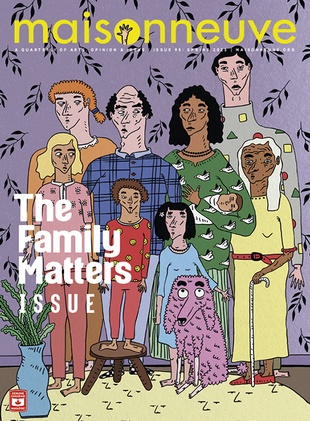The Winter Dance Season Begins
The First 2006 Montreal Dance Shows
The winter season of Montreal dance got off to a quiet start a couple of weeks ago with just a two-program offering from Tangente. By the following week, more shows opened, including the greatly anticipated James Kudelka/Coleman Lemieux & Compagnie program. Here's a rundown and a list of this week's offerings.
Tangente's Bancs d'Essai International
I was able to make only the first of Bancs d'Essai International's two programs and enjoyed the low-key evening that its three works provided. First up was Nicolas Cantin with his "Glass*house-fantaisie baroque." I was happy to see the work again, but this solo work, which takes place in a small illuminated space, lacked some of the power and magic of its debut last fall. "Glass*house" seems to me to work best as a piece that comes after a few works that have more brightness and larger movement. It needs something to contrast with, and when it does, it is an extra pleasure to concentrate on Cantin's minute gestures.
Following Cantin was Luxembourg's Gianfranco Celestino in an extract from his Solo con piano, an exploration of the relationship between those closest-of-arts siblings, dance and music. I happen to love works that make this theme explicit, particularly those in which a piano becomes a character itself. Think of the "Tra La La La" number in An American in Paris with Gene Kelly dancing around (and on) both a piano and a pianist (Oscar Levant) or the more recent Play It Again! by Montreal choreographer Danièle Desnoyer.
In Celestino's work, however, the choreographer/dancer is the piano man too and a clearly good one to boot. Besides Celestino playing up a storm on the instrument, the piano itself had a few contributions of its own, via a recorded score/soundscape by Emre Sevindik, which alternately spooked or propelled Celestino into movement.
One recurring pose Celestino struck still reverberates in memory. Standing with one foot behind the other in a back coupé, he turned his head to the right and stretched his arms across his body in the same direction with his wrists together while his fingers quickly "played" one another as if they were piano keys. A rather classical look overall, except for those agile fingers tickling the ivories, so to speak. At once I become more aware of just how complicated the relationship between music and dance is: it takes a body to make a piano sing, and a piano singing in turn makes a body move.
Lastly on the program was (get this title) "The Agony and Tragedy of Enjoying Life and Having a Fun Show" brought to Montreal by Great Britain's Marega Palser and Gareth Clark, otherwise known as "Mr. and Mrs. Clark." It was a surreal mix of images and emotions from start to finish. During the first vignette, both wore masks-with Palser in a nun's habit and Clark in a priest's garb. At one point, Clark attached a leash to Palser, who for quite some minutes bounced back and forth from foot to foot to a techno beat while Clark stood behind and occasionally jerked the leash. I was quite amused though disturbed by my own amusement. By the end, enjoyment prevailed.
James Kudelka/Coleman Lemieux & Compagnie
What a program! Get a load of this: Kudelka's first new work since he stepped down from the artistic directorship of the National Ballet of Canada. And how about this bonus for those-like me-relatively new to Canada and those too young to have attended the premieres of "Fifteen Heterosexual Duets" (Toronto Dance Theatre, 1991) and "Soudain, l'hiver dernier" (Montréal Danse, 1987). If that were not enough, how about the chance to see a motherload of amazing dancers of different ages and backgrounds: Laurence Lemieux, Bill Coleman, Anik Bissonnette, Andrea Boardman, Victor Quijada, Anne Plamondon, Mario Radacovsky, Sasha Ivanochko, Andrew Giday, Marc Bovin, and Sylvain Lafortune. Finally, add the pure and clear tones of countertenor Daniel Taylor and his group Theatre of Early Music. Whoa!
I think just about everyone in Montreal was looking forward to this one. Proof positive-the three originally planned performances sold out and a fourth was added. I attended two of them and I am happy to say that what went on onstage for the most part fulfilled my expectations. Most heartening too was the sight in the audience of members of both the ballet and contemporary dance communities (that's a sight not seen enough). Look for an extended report in my regular column, "The Dance Scene," on this website in a couple of weeks.
(Kudelka fans take note: the same week as the Montreal success, the National Ballet of Canada was in Washington DC performing his version of Swan Lake. The reviews out of DC have not been good-a real contrast from the positive notices for Boston Ballet's run of Kudelka's Cinderella just this past fall.)
On My Calendar
David Pressault's Lost Pigeons, Monument-National, January 25-28 (and February 1-4).
Dominique Porte's Exit, Système D, L'Agora de la Danse, Janurary 26-28.
Johanne Madore's Le Baiser, Corpuscle Danse, Espace Libre, January 26-28. For info, (514) 521-4191.
Solid State, IT'S NOT YOU... IT'S ME... Tangente, January 26-29.
Beyond Performances
A lot is going for me on the dance-film front. The documentary on the Ballets Russes is finally running at the AMC Forum. And I wait with baited breath for my copy of the new DVD of the 1951 dance film (based on the opera) Tales of Hoffmann. I haven't seen this one since I was a kid. All I remember was Moira Shearer's wonderful pointe work and the completely out-of-this-world blazing Technicolor. Meanwhile, with much enjoyment, my family and I continue to make our way through a DVD collection of Charlie Chaplin films. Chaplin may not have been a dancer/choreographer per se, but he sure gives dance artists a run for their money when it comes to physical adroitness and insight into the human condition through movement alone. More thoughts on Chaplin from me to come.





